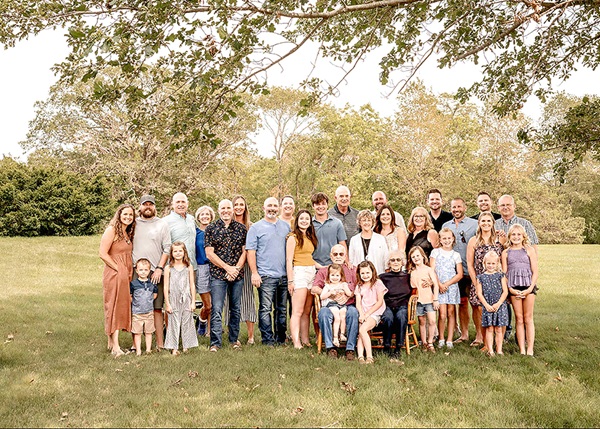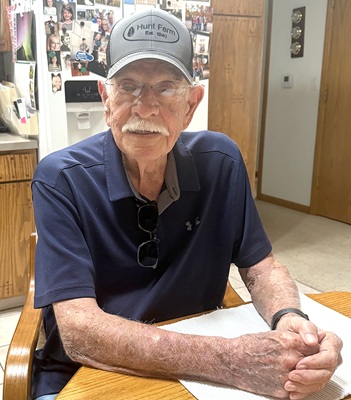
The Hancock-Henderson Quill, Inc.
Laura Wilhite, The Quill

 Ed Hunt was born in 1934, in Tennessee, Illinois, during the Great Depression and Dust Bowl era. His father was a tenant farmer; a hard worker who didn’t own land until 1940 when he bought the farm they ended up calling home.
Ed Hunt was born in 1934, in Tennessee, Illinois, during the Great Depression and Dust Bowl era. His father was a tenant farmer; a hard worker who didn’t own land until 1940 when he bought the farm they ended up calling home.
Ed stated that there was no wealth in their family, just grit, faith, and determination.
Ed was one of six kids—three boys and three girls. The girls slept in one big room upstairs, and the boys in the other.
The original house didn’t even have a second story, but his dad and some local corn crib carpenters lifted the whole structure and built an upstairs. That house is still standing today, though it’s been added onto over the years.
Ed’s mother was a remarkable woman. She went to college at Western when it was still a teacher’s college. Ed has a photo of her on the front steps there, dressed in a 1920s outfit.
She taught in a one-room schoolhouse, fired the furnace in the mornings, cut the boys’ hair, and taught every subject under the sun.
She gave up teaching when she started having children—six of them in ten years. She helped on the farm in every way she could, always making sure the family came first.
Ed stated, “I probably didn’t appreciate her enough at the time. It’s funny how you don’t see the full picture until someone’s gone”.
Millie, Ed’s late wife, designed the house he lives in now. She had
vision and practicality, right down to the sliding doors she had installed, saying, “One day, they’ll wheel me out through those when I pass.”
And that’s exactly how it happened. She was financially savvy, strong, and incredibly supportive.
Ed met Millie at a bonfire during Homecoming in La Harpe. He rode in on a motorcycle with a friend, and she rode back with him. Ed was not a big biker, but he remembers one ride to Crapo Park where Millie packed fried chicken in his saddlebags.
They dated for a few years before marrying at a church in Colchester.
She was the only woman Ed ever seriously dated. After they got married, they lived in a little rental house in Fountain Green for six months before moving back to Blandinsville. Ed’s roots have been planted there ever since.
Millie’s father died young—only 42. Her family had farmed down by the round barn near Fountain Green, but after he passed, they sold the farm and moved into town, running a general store there. That’s where she lived during high school.
Farming was always what Ed wanted to do. He started in 1957, back when tenant farming was still common. His father had been a tenant farmer.
He worked the land and shared the crop with the landowner. Very few farmers back then owned the land they worked.
Ed started out with just what he needed—a WD-45 Allis-Chalmers tractor. His brother had one, too. Between the two of them, they made it work. Over time, they expanded.
Ed is proud of the fact that every new tractor he ever bought came from dealers right in Blandinsville. He went from Allis-Chalmers to International Harvester, to Massey Ferguson, and then back to Allis when Neil Moore brought the dealership back. That loyalty mattered to him.
Eventually, Ed met his goal of farming 1,000 acres, though he didn’t own it all. A lot of it was rented, which is how most farmers get by. One of the farms Ed rented out by Sciota they have now farmed for 50 years.
Over the decades, Ed has ran a variety of combines—Gleaners, Massey Fergusons, and the early axial-flow models from International Harvester. He has pictures of every one of them.
Ed has a “hall of fame” in his office which consists of photos of all the equipment that helped build this life.
Ed and Millie had three children Brad, Dave and Anna. Their daughter continued the farming legacy with a degree in Agriculture Business at Western Illinois, and helped her husband, Greg on their family farm while the kids were small. She then finished her MBA and pursued a career advising students, some in Agriculture.
She was fortunate enough to advise her great-nephew, Clayton Hunt, before her retirement at the end of September. She still continues to market grain and complete farm books for the farm.
Their oldest son, Luke, is the Dealer-Manager for AgLeader Technology and works with farmers across the country and Canada. Brice chose his mother's path and works for the Registrar at the University of Southern California in Los Angeles.
Brad and Dave are farmers. Dave and Brad started working with him shortly after high school. Dave joined early.
There was a program at school that let him leave early to work. Dave also took welding classes in Fountain Green through a program connected to Spoon River College. That training served him well.
Brad and Dave became a part of the farm, and it just grew from there. They didn’t have a master plan—they just took it one day, one week, and one season at a time. Eventually, they began hiring help from outside the family.
Hunts have always tried to do as much of the work themselves. They spread their own lime and fertilizer, and hauling what they can.
They have 5-7 trucks out daily. Everyone’s has their CDL. Ed had his until he gave it up at 85 or 86.
Ed retired around age 70, but not completely. He still helps out here and there. He doesn't want to get in the way, but he also can’t just walk away from something he built.
There’s never just one “head” of Hunt Farms. It’s always been a group effort. Ed stated, “the guys doing the work deserve the credit. The younger generation keeps things going.”
When asked how daily operations run so smoothly Ed stated, “They hold weekly meetings now, something we never did back then. That started when Monte Mason, a cousin, joined. He brought in that structure. With so many people and so many fields, it was necessary.”
Hunt Farms is spread across McDonough, Hancock, Henderson, and parts of Warren County. They track all of their fields with software that Ed is still getting used to.
When asked what advice Ed had for a young farmer he stated, “Get in there and go to work. Set goals that you can actually meet. Don’t dream so big that you freeze. You’ll never know until you start.”
Ed has great-grandsons stepping in now.
Ed stated, “Technology changed everything. I remember shelling corn by hand, throwing it into corn cribs.
“Then came dryers and bins. You had to dry your corn or risk losing it all. You didn’t always want to haul it straight to town. Having options was key.”
Hunts usually start harvest near Labor Day and go until November. Ed always believed in starting early.
He stated, “You can’t finish if you don’t start. If anything, I may have started too soon some years—but better that than too late.
“When the beans shatter and the corn dries up, you lose more than just yield. You lose what you worked for.”